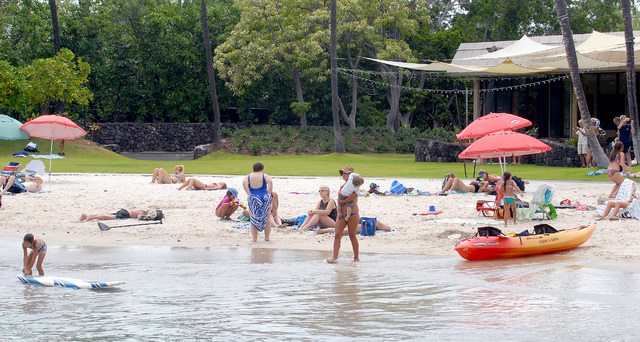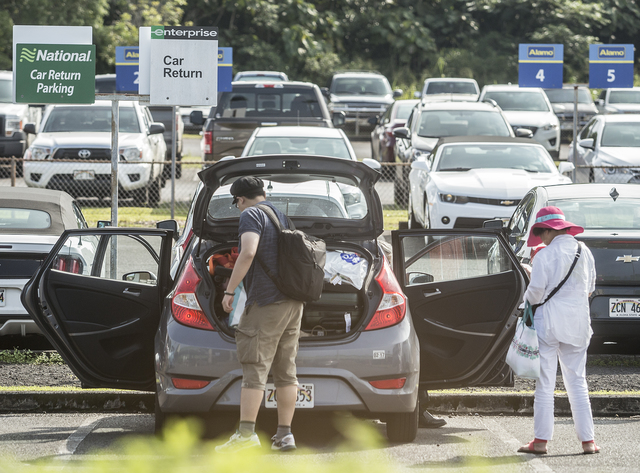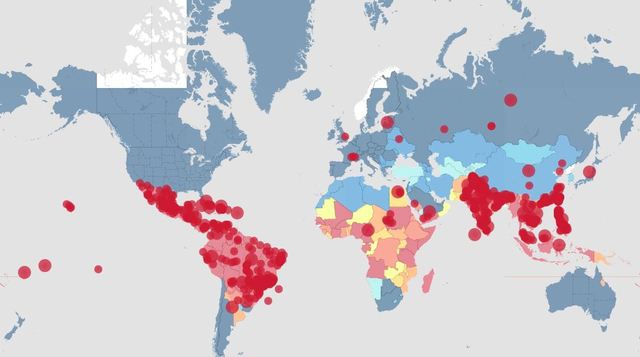The Big Island’s tourism industry appears to have been spared the bite from the ongoing dengue fever outbreak, but some worry that could change if the number of infections from the mosquito-borne illness continues to rise.
Health officials confirmed another case of dengue fever on the island Tuesday, bringing the total from the outbreak to 93.
That surpasses the number of cases recorded during an outbreak on Maui in 2001.
Of the Big Island cases, 13 have involved visitors, according to the state Department of Health.
Echoing statements from other business leaders, Big Island Visitors Bureau Executive Director Ross Birch said there have been a “few” cancellations at island hotels as result of the outbreak, but exact numbers weren’t available.
He considers the impact so far to be small.
“All in all, we’re not seeing much of a change at all,” Birch said. “It’s still too early to know what type of effect it’s going to have.”
Kirstin Kahaloa, Kona-Kohala Chamber of Commerce executive director, said the organization’s members, including the area’s resorts, are worried about tourists being scared away.
“It’s not just health and safety,” she said. “It’s also how it affects the economy, and that is critical as well.”
Kahaloa said the hotels and other businesses have been responding to questions from their customers regarding the outbreak and are taking steps to reduce any mosquito populations on their properties.
But, for the most part, they are not bringing up the issue unless asked, she said.
“I think the reason is they are trying not to scare away tourists,” Kahaloa said.
The hospitality industry can take some comfort from a statement a Centers for Disease Control and Prevention official made last week regarding the island being safe to visit.
“If you consider how many tens of thousands of people come to the islands every day, the risk is extremely small,” Dr. Lyle Petersen, CDC’s Division of Vector-Borne Diseases director, told the Associated Press. “Simple measures like mosquito repellent … greatly reduce your risk.”
Ilihia Gionson, an executive assistant to Mayor Billy Kenoi, said Petersen will visit the island Tuesday to provide an on-the-ground assessment.
Birch said the visitors bureau is forwarding information it gets from health officials regarding the outbreak to island businesses. How they provide that information to customers is being left up to them, he said.
“From the visitors side, once they get here, we really rely on our hospitality partners to really take more of the lead,” Birch said.
On the east side of the island, customer service representatives at hotels and car rental companies are finding themselves on the front lines when it comes to educating visitors about the outbreak.
“When we first had that (report), I was kind of scared,” said Peggy Pacheco, who was working at the Alamo front desk at Hilo International Airport on Tuesday. She said she educated herself about the topic and is helping answer questions from customers.
Aaron Correa, a managing assistant at Enterprise, said he has been asked questions from a couple of mainland visitors, mostly regarding where the disease is occurring and where they can buy repellent.
None of the car rental companies appeared to have had printed material on the outbreak available for customers.
During the Maui outbreak, health officials “engaged car rental agencies and hotels to distribute educational brochures for travelers and tourists,” according to a CDC report.
According to the Health Department, Hawaii County Civil Defense is in the process of negotiating a more uniform educational effort with rental car companies.
Darryl Oliveira, Civil Defense administrator, couldn’t immediately be reached for comment late Tuesday afternoon.
Dengue symptoms include high fever, severe headache, severe pain behind the eyes, joint pain, muscle and bone pain, rash and mild bleeding, according to the CDC.
The Big Island isn’t the only place in the United States grappling with dengue.
In Puerto Rico, also a tourist destination, the disease has long been endemic. The most recent islandwide epidemic there was in 2007, when more than 10,000 cases were diagnosed, according to the CDC.
This year, the U.S. territory has seen 1,527 suspected cases through Nov. 4, with 33 confirmed by laboratory testing. That’s below its historical average.
Email Tom Callis at tcallis@hawaiitribune-herald.com.











